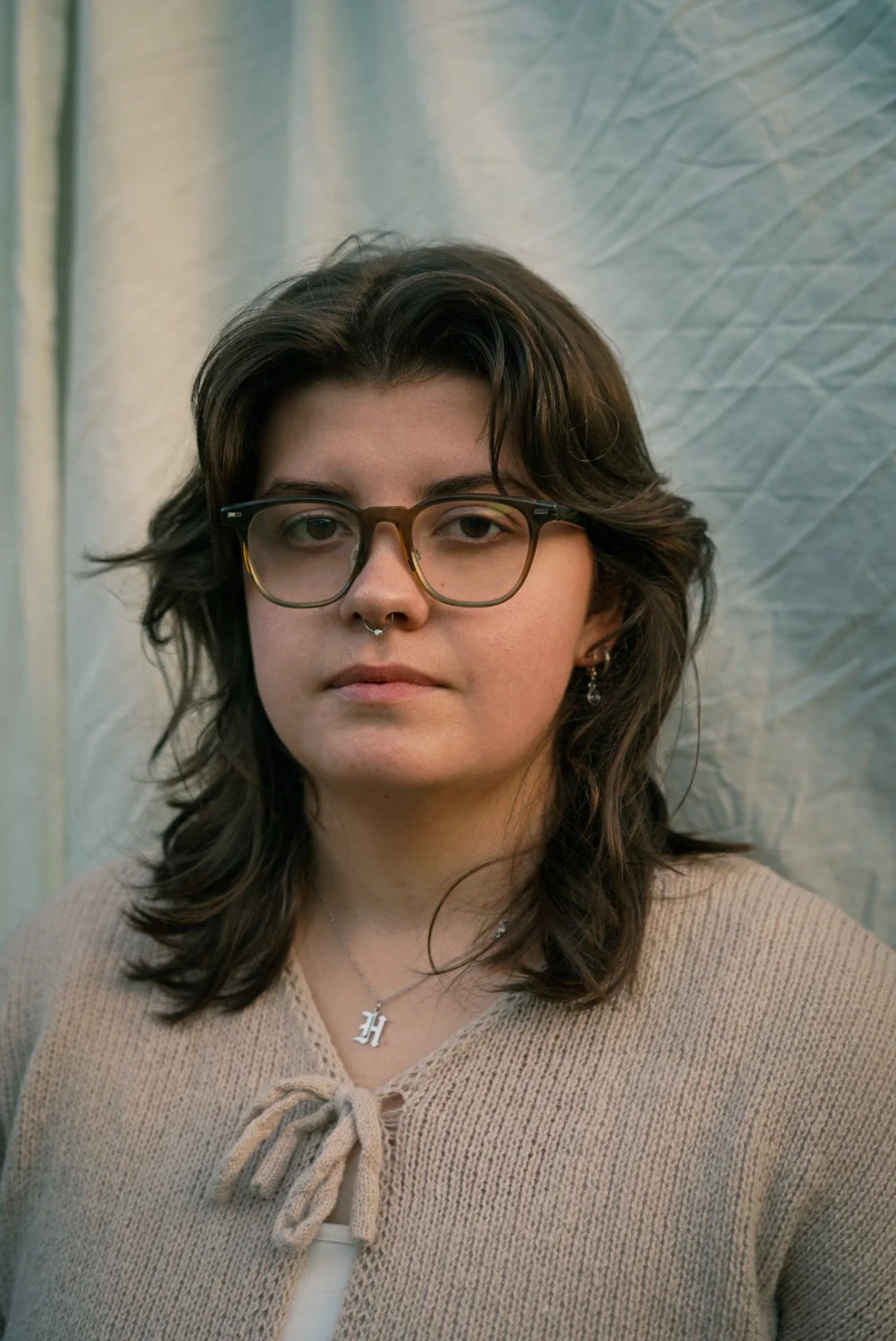10 Questions with Bee Jones - Motionmoth
Al-Tiba9 Art Magazine ISSUE19 | Featured Artist
Bee Jones (Motionmoth) is a queer photographer and visual artist based in Manchester, but hailing from West Yorkshire. Having been published in works such as Runt Magazine, their work is slowly emerging within the industry. They specialised in Photography at Manchester Metropolitan University's School of Art after completing a foundation degree at Leeds Arts University.
Bee Jones - Motionmoth - Portrait
ARTIST STATEMENT
Jones' work takes an autobiographical and almost documentary form, with the aim of unearthing the ordinary and dragging it into the limelight. Drawing on important sociopolitical themes such as sexuality and class, Jones consistently endeavours to push their own life's narrative and the stories of those around them into their work. This can be dark, and sometimes shocking.
Domestic Bliss Pt. 1, Photography, 21x29.7 cm, 2025 © Bee Jones - Motionmoth
AL-TIBA9 ART MAGAZINE ISSUE19
Get your limited edition copy now
INTERVIEW
How did you first get into photography, and what made you want to pursue it seriously?
Photography has been a big part of my life since I was a child. My grandparents had photos and albums everywhere, my dad recorded my early childhood on a video camera, and everything was documented on a camera. I bought an untested Canon 500N film camera from eBay with my pocket money when I was 14, and it just grew from there. I chose photography on a whim at college and realised there was something I just loved about the labour of love every roll of film became.
I knew I wanted to pursue it seriously when I realised there were stories that needed to be told. Parts of our upbringing were affected by political instability, horrendous things going on globally, and grim realities within the LGBT+ community, which is a big part of my identity. I wanted to consistently tell the stories of those who haven't been heard.
Domestic Bliss Pt. 1, Photography, 21x29.7 cm, 2025 © Bee Jones - Motionmoth
You describe your work as autobiographical. What's it like turning your own life and experiences into art?
It can be rewarding, and sometimes feel like a real accomplishment, to visualise difficult topics that I'd otherwise find hard to discuss. It can be therapeutic. But sometimes, it feels outright terrifying. Sometimes, realising a piece of autobiographical work feels like a physical admission that these experiences really happened. While it helps in processing my experiences, it can be really challenging personally to bring these to light.
Are there certain moments or emotions that you find yourself drawn to capturing again and again?
I find myself repeating and developing work about political instability and the LGBT+ community - it's been the same since college. When I was studying, I did a whole year's project in Textiles about growing up in Northern England, and I always feel like I've got unfinished business with it. I'm working on a project called New Britannia at the moment, which I hope will consolidate that.
I also did a whole term project on Stonewall and the LGBT+ community in Photography, but my tutors told me verbatim they'd 'seen it a thousand times'. Being 17, I didn't challenge that; I thought they knew better. Now I know it might have been seen a thousand times, but it doesn't make it any less important.
Domestic Bliss Pt. 2, Photography, 21x29.7 cm, 2025 © Bee Jones - Motionmoth
Domestic Bliss Pt. 2, Photography, 21x29.7 cm, 2025 © Bee Jones - Motionmoth
Domestic Bliss Pt. 2, Photography, 21x29.7 cm, 2025 © Bee Jones - Motionmoth
Your work often explores themes like sexuality and class. Why are these topics important for you to share through your art?
Sexuality is important to me as it's been a consistent worry throughout my life. While better than other countries, a small rugby town in Northern England isn't the most comfortable place to grow up as a lesbian. It's always been important to me to have that voice in sharing my experiences to help me come to terms with my identity.
As for class, I owe a lot to my family, and I make work about class to give them a voice. My grandparents and especially my mum sacrificed a lot for me and my sister when we were growing up. My nana was a nurse (one of the longest serving in the UK) and my grandad was a miner. His job was constantly on the line during Thatcher's reign, and the mental effects are still evident in my family (and others, I'm sure) even now.
It might be too little too late, but having the opportunity to give them and others a voice with my work is my priority.
Do you usually plan your shoots, or do you prefer to capture things as they happen?
I used to capture things on a whim, but now I find I have to plan it to make sure every base is covered. I often have a lot to say, and I have to make sure I plan shoots so I can say it all; otherwise, I miss things.
You've been published in different magazines, like Runt Magazine. How does it feel to see your work out in the world and start to gain recognition?
Bizarre. I'm so grateful that I have these opportunities. Don't get me wrong, it's so wonderful that people enjoy my work. I've worked hard to get the opportunities I have, but I think I've got a bit of impostor syndrome. I've always had constant criticism of my work, and being on the internet, I get a fair amount of hate. So when people like it or want to feature it, the voice in my head is like 'Really? Surely not.'
Domestic Bliss Pt. 2, Photography, 21x29.7 cm, 2025 © Bee Jones - Motionmoth
Domestic Bliss Pt. 2, Photography, 21x29.7 cm, 2025 © Bee Jones - Motionmoth
Are there other photographers or artists who inspire you or whose work you admire?
Nan Goldin's work was invaluable to the LGBT+ community during the AIDS epidemic. I think we all have a great debt to owe her for the amount of light she shed on drag queens and queer people alike.
Jo Spence's work sparked my interest in autobiographical photography. The way she used photography as therapy to deal with her cancer diagnosis pioneered the way artists use their cameras to tell stories even now.
Some of your images can be dark or raw. What kind of reactions do you hope people have when they see your work?
The intention is for them to hit hard. I've always been drawn to dark imagery, possibly because a lot of the photography I saw as a child was black and white. It's where I'm most comfortable working even now. Working with dark and raw imagery allows me to accentuate details and play with the image properly to create my narrative.
Domestic Bliss Pt. 2, Photography, 21x29.7 cm, 2025 © Bee Jones - Motionmoth
What are you currently working on, or dreaming about working on next?
Again, it's a labour of love, but I'm working on a project called New Britannia at the moment. It's about life in Northern England post-Thatcher, how this has progressed (the Reform party) and the effect it's had on the younger generation. It intends to flip the stereotypes of the left wing on its head.
Lastly, where do you see yourself in five years? What do you think the future holds for you?
My hope for the next 5 years is that I have the privilege of telling the stories of the unheard and doing something good for my family. Like I mentioned before, I owe a lot to them, and truly everything I do is for them. I hope the future holds the privilege of pursuing my passion to help others and tell their stories.
Artist’s Talk
Al-Tiba9 Interviews is a curated promotional platform that offers artists the opportunity to articulate their vision and engage with our diverse international readership through insightful, published dialogues. Conducted by Mohamed Benhadj, founder and curator of Al-Tiba9, these interviews spotlight the artists’ creative journeys and introduce their work to the global contemporary art scene.
Through our extensive network of museums, galleries, art professionals, collectors, and art enthusiasts worldwide, Al-Tiba9 Interviews provides a meaningful stage for artists to expand their reach and strengthen their presence in the international art discourse.


























